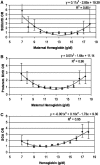U-shaped curve for risk associated with maternal hemoglobin, iron status, or iron supplementation
- PMID: 29070565
- PMCID: PMC5701708
- DOI: 10.3945/ajcn.117.156075
U-shaped curve for risk associated with maternal hemoglobin, iron status, or iron supplementation
Abstract
Both iron deficiency (ID) and excess can lead to impaired health status. There is substantial evidence of a U-shaped curve between the risk of adverse birth outcomes and maternal hemoglobin concentrations during pregnancy; however, it is unclear whether those relations are attributable to conditions of low and high iron status or to other mechanisms. We summarized current evidence from human studies regarding the association between birth outcomes and maternal hemoglobin concentrations or iron status. We also reviewed effects of iron supplementation on birth outcomes among women at low risk of ID and the potential mechanisms for adverse effects of high iron status during pregnancy. Overall, we confirmed a U-shaped curve for the risk of adverse birth outcomes with maternal hemoglobin concentrations, but the relations differ by trimester. For low hemoglobin concentrations, the link with adverse outcomes is more evident when hemoglobin concentrations are measured in early pregnancy. These relations generally became weaker or nonexistent when hemoglobin concentrations are measured in the second or third trimesters. Associations between high hemoglobin concentration and adverse birth outcomes are evident in all 3 trimesters but evidence is mixed. There is less evidence for the associations between maternal iron status and adverse birth outcomes. Most studies used serum ferritin (SF) concentrations as the indicator of iron status, which makes the interpretation of results challenging because SF concentrations increase in response to inflammation or infection. The effect of iron supplementation during pregnancy may depend on initial iron status. There are several mechanisms through which high iron status during pregnancy may have adverse effects on birth outcomes, including oxidative stress, increased blood viscosity, and impaired systemic response to inflammation and infection. Research is needed to understand the biological processes that underlie the U-shaped curves seen in observational studies. Reevaluation of cutoffs for hemoglobin concentrations and indicators of iron status during pregnancy is also needed.
Keywords: anemia; ferritin; iron deficiency; iron supplementation; low birth weight; pregnancy; preterm birth; small-for-gestational age; soluble transferrin receptor; stillbirth.
© 2017 American Society for Nutrition.
Figures
References
-
- Drakesmith H, Prentice AM. Hepcidin and the iron-infection axis. Science 2012;338:768–72. - PubMed
-
- Garn SM, Keating MT, Falkner F. Hematological status and pregnancy outcomes. Am J Clin Nutr 1981;34:115–7. - PubMed
-
- Chang SC, O’Brien KO, Nathanson MS, Mancini J, Witter FR. Hemoglobin concentrations influence birth outcomes in pregnant African-American adolescents. J Nutr 2003;133:2348–55. - PubMed
Publication types
MeSH terms
Substances
LinkOut - more resources
Full Text Sources
Other Literature Sources
Medical



